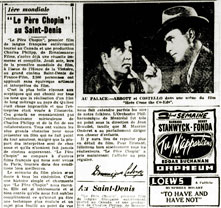Renaissance Films
-

Poster for the film Le gros Bill (René Delacroix and Jean-Yves Bigras, 1949).
Source : Cinémathèque québécoise, 2004.0210.AF.01
-

A letter to the shareholders of Renaissance-Film.
Source : Cinémathèque québécoise, 1989.0169.27.AR
-

Le Petit Journal, 18 September 1949, p.1
Source : Bibliothèque et Archives nationales du Québec
-

Le Petit Journal, 21 July 1946, p.32
Source : Bibliothèque et Archives nationales du Québec
-

La Patrie, 21 April 1945, p.38
Source : Bibliothèque et Archives nationale du Québec
-

Hector Charland and Estelle Maufette preparing a new episode of the radio serial Un homme et son péché
Source : Cinémathèque québécoise, 2001.0658.PH.0425
In 1944 came a surprise: Quebec’s first feature-length film, Le père Chopin, was released. It was produced by Renaissance Films, a new company founded by a French immigrant who came to Montreal to set up a production centre. A few months after the film was made, J.A. DeSève founded Renaissance Films Distribution (RFD), which swallowed up the first company. RFD’s goal was to produce Catholic cinema and to work with Catholic filmmakers in France. For two years, funds were raised to build a studio in an old military barracks on Côte-des-neiges street in Montreal. The situation stagnated, however, and conflicts arose between the shareholders and DeSève, who was pushed aside. In the end the company created a new entity, Les Productions Renaissance, which finally produced a new feature film, Le gros Bill (René Delacroix, 1949), and then a second one in co-production with France, Docteur Louise (René Delacroix, 1949), followed by Lumières de ma ville (Jean-Yves Bigras, 1950). Despite appearances, the company was derelict and declared bankruptcy in 1951. DeSève got his hands on its assets and the studio was used for film shoots for a few years more. The adventure of French-language Catholic cinema was a financial and commercial failure.
Inevitably, Renaissance’s films are compared with those of Québec Productions. Renaissance films were less famous and less significant. They did not draw on the same familiar literary or radio sources. At the same time, they were very much in keeping with the cultural context of the day. The company’s first two films showed picturesque rural images, while its final film demonstrated a move towards modernity, with references to city life, youth and song. Their form, however, was rather conventional, and their scripts did not withstand comparison to the foreign films on offer at the time. What then are we to make of this adventure, beyond the four feature films that came of it? The connection with France brought to Quebec the film director René Delacroix and various technicians, some of whom stayed. But it was difficult, if not impossible, to establish a film industry in Quebec based on foreign production models. Nevertheless, to promote its activities and raise funds, in 1949 RFD had Henri Michaud shoot a colour documentary on its activities, Coup d’oeil au studio, which is one of the most interesting glimpses of Quebec film production of the day we have.